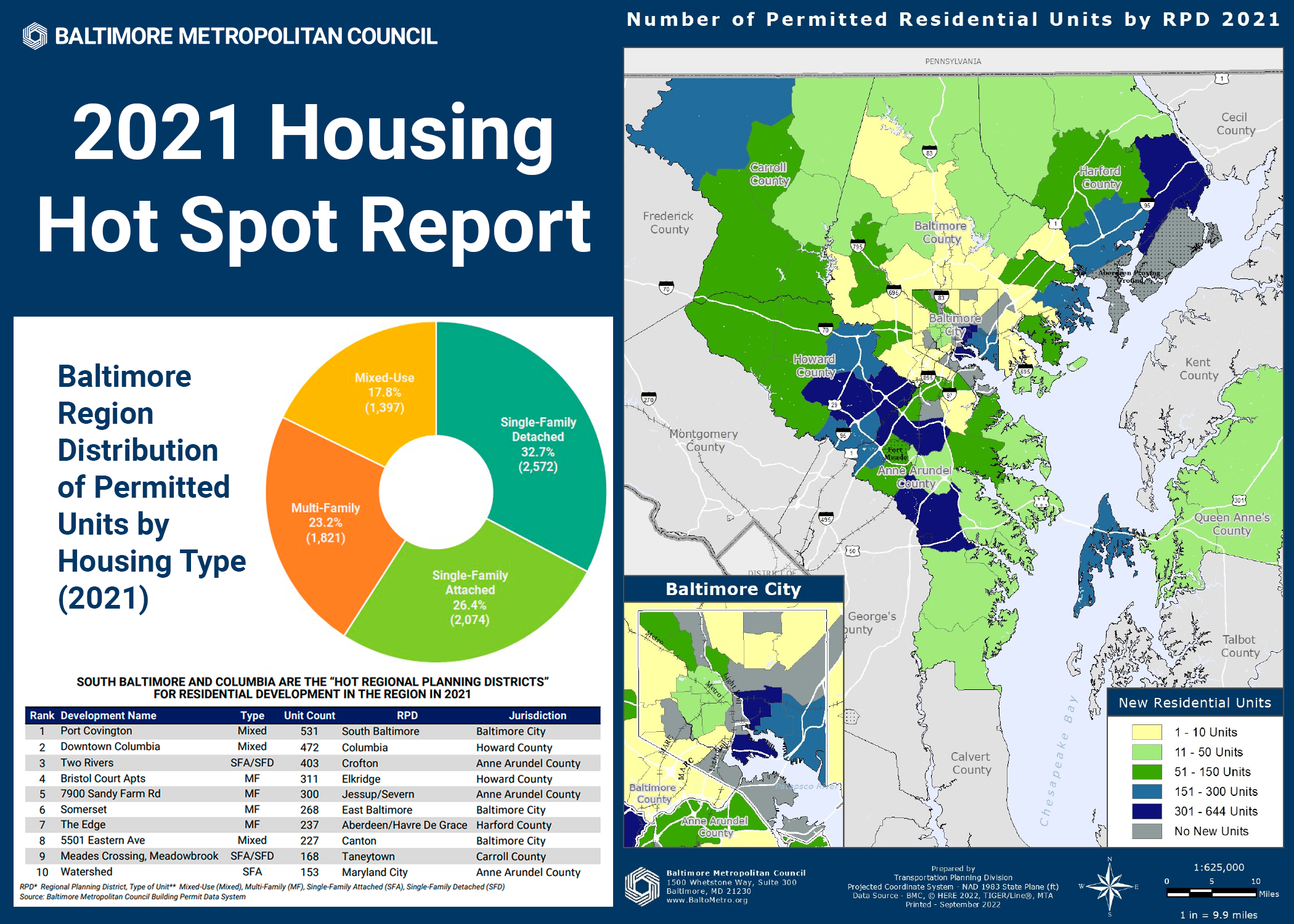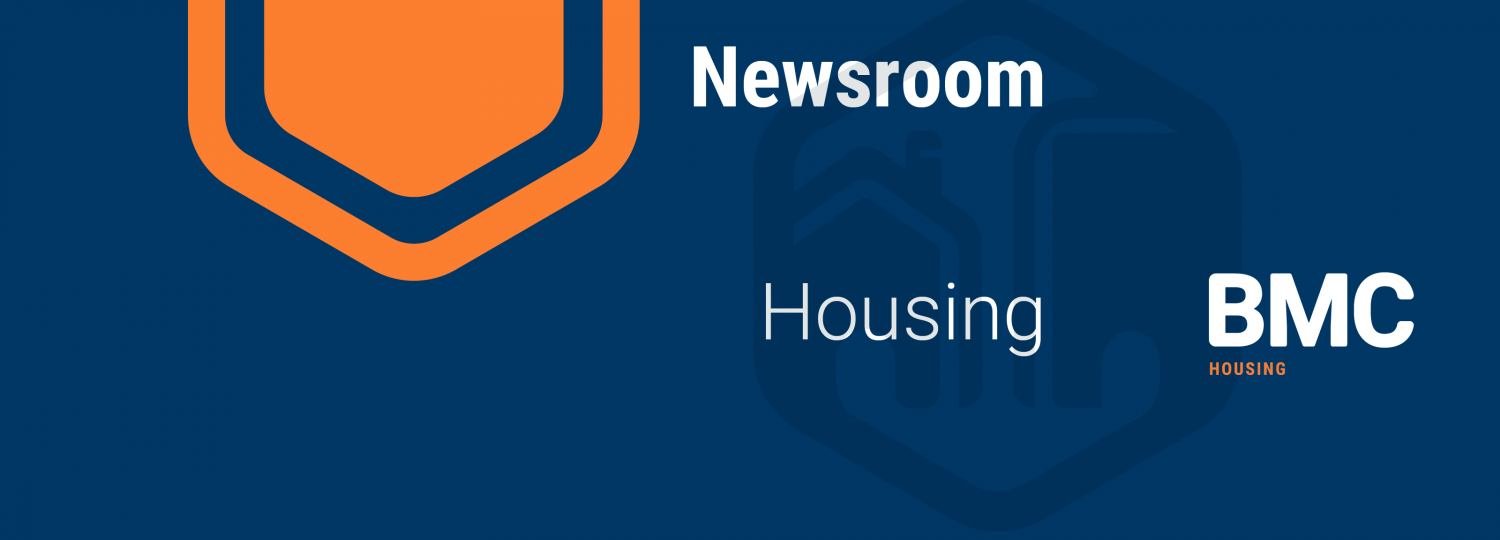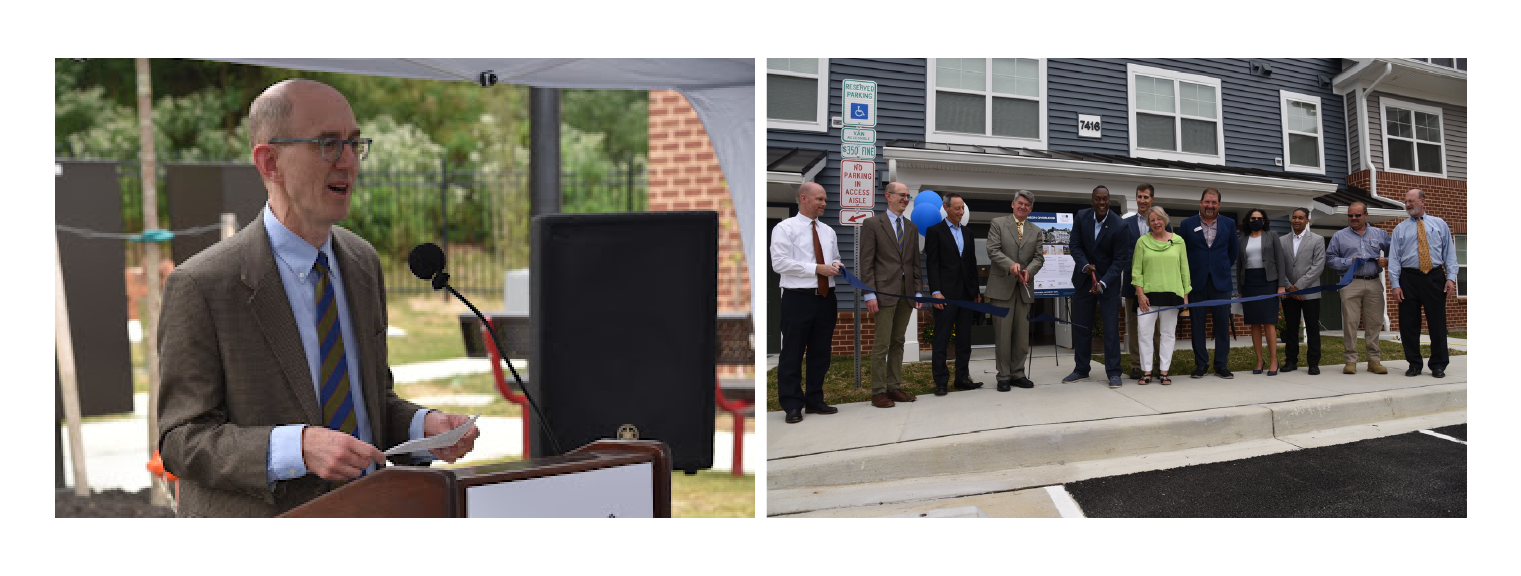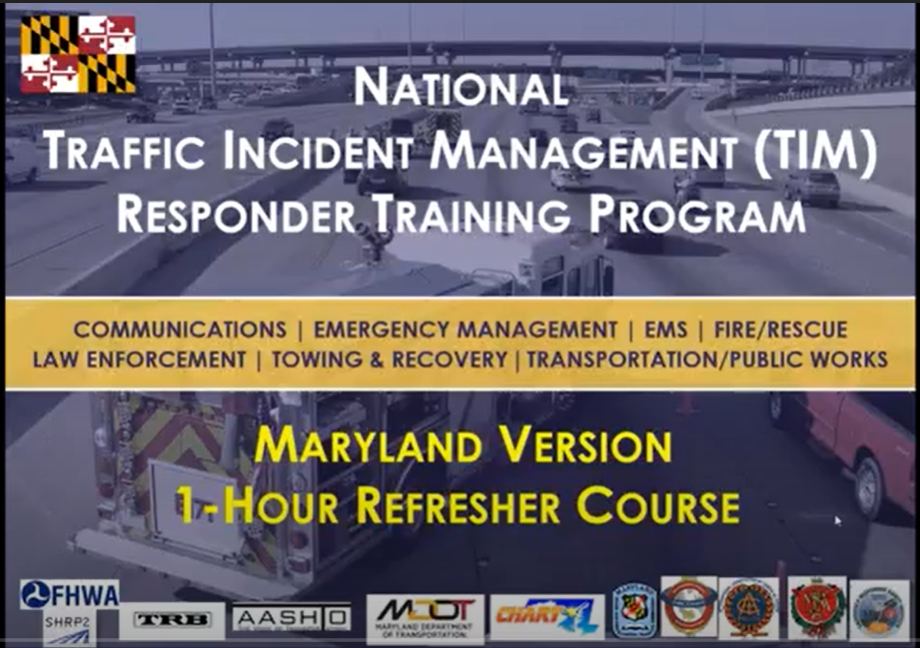El Informe de puntos calientes de vivienda de 2023 identifica el crecimiento en toda la región
BALTIMORE, MD (lunes 22 de julio de 2024) – Los sitios en Ten Hills, Edgewood y el sur de Baltimore están emergiendo como los 'puntos calientes' para el desarrollo residencial en la región de Baltimore, según el último Informe de puntos calientes de actividad de permisos de construcción residencial de Consejo Metropolitano de Baltimore (BMC).
En 2023, se permitieron 7298 unidades residenciales en la región de Baltimore. Este informe anual se basa en datos de la información de permisos de construcción de la región en una base de datos estandarizada.
El director ejecutivo de BMC, Mike Kelly, dice que los líderes de la región de Baltimore están evaluando esta tendencia y sus implicaciones para las oportunidades de la región para la propiedad de viviendas generadoras de riqueza y una red de transporte en crecimiento.
"Esperamos que la población de la región siga creciendo en los próximos años debido a nuestra calidad de vida y oportunidades económicas", dice Kelly. "Para respaldar este crecimiento, las nuevas familias, trabajadores, estudiantes y jubilados necesitarán más opciones de vivienda".
BMC trabajará con los gobiernos locales de la región durante el próximo año para explorar las interacciones entre viviendas nuevas y existentes, la red de transporte de la región, las oportunidades económicas y el sentimiento público. Esto incluye un próximo estudio sobre las disparidades relacionadas con la vivienda justa en la región, que investiga cómo la desigualdad corresponde a las características protegidas por las leyes de vivienda justa.
Los datos del Informe de puntos críticos de actividad de permisos de construcción residencial de BMC acompañan al Informe de actividad de construcción metropolitana de 2023 y brindan información esencial para nuestra comunidad. El Informe Metropolitano de Actividad de Construcción detalla las tendencias en el total de permisos para unifamiliares, multifamiliares y de uso mixto e incluye datos sobre todas las construcciones residenciales y no residenciales. En conjunto, estos informes brindan información sobre los nuevos patrones de desarrollo regional en nuestra región.
En 2023, la ciudad de Baltimore recibió la mayor cantidad de permisos para unidades residenciales, con 1,944 unidades permitidas. Le siguieron el condado de Baltimore y el condado de Harford con 1,674 y 1,149 unidades permitidas, respectivamente.
Los diez principales "puntos calientes de vivienda" de la región importantes para desarrollos residenciales en 2023 fueron:
- Upton (Ten Hills, ciudad de Baltimore) con 761 unidades multifamiliares
- James Run (Edgewood/Joppa, condado de Harford) con 390 unidades adjuntas multifamiliares y unifamiliares
- Península de Baltimore (sur de Baltimore, ciudad de Baltimore) con 386 unidades adjuntas multifamiliares y unifamiliares
- Hunt Valley Town Center (Cockeysville/Timonium, condado de Baltimore) con 322 unidades multifamiliares
- Arundel Gateway/Watershed (Ciudad de Maryland, condado de Anne Arundel) con 233 unidades unifamiliares adjuntas
- Waters Landing (Essex, condado de Baltimore) con 181 unidades unifamiliares adjuntas
- Wellington Farms (Laurel, condado de Howard) con 171 unidades unifamiliares adjuntas y separadas
- Four Seasons Kent Island (Kent Island, condado de Queen Anne) con 156 unidades unifamiliares independientes y multifamiliares
- Columbia Village (Columbia, condado de Howard) con 155 unidades multifamiliares
- Perkins Homes (East Baltimore, Baltimore City) con 152 unidades multifamiliares
Del total de permisos emitidos en 2023, el 45,9 por ciento del total de permisos residenciales fueron para desarrollos multifamiliares, mientras que el 27,3 por ciento fueron para viviendas unifamiliares adjuntas y el 22,6 por ciento fueron para viviendas unifamiliares independientes. Por el contrario, en 2022, el 54,7 por ciento del total de permisos residenciales fueron para desarrollos multifamiliares o de uso mixto, convirtiéndose en la mayoría de los permisos emitidos por primera vez, mientras que el 23,3 por ciento fueron para viviendas unifamiliares adjuntas y el 22 por ciento para viviendas independientes. viviendas unifamiliares.
BMC recopila y mantiene la información sobre permisos de construcción de la región en una base de datos estandarizada, proporcionando un registro continuo de los planes para proyectos residenciales y no residenciales nuevos y renovados de todos los permisos con un valor de construcción estimado de $10,000 o más. Esto ayuda a las agencias locales y estatales a prepararse para las tendencias anticipadas a medida que las comunidades crecen con el tiempo.
###
El Consejo Metropolitano de Baltimore (BMC) trabaja en colaboración con los principales funcionarios electos de la región para crear iniciativas que mejoren la calidad de vida y la vitalidad económica. Como consejo de gobiernos de la región de Baltimore, BMC alberga la Junta de Transporte Regional de Baltimore (BRTB) y apoya al gobierno local coordinando esfuerzos en una variedad de áreas de políticas que incluyen preparación para emergencias, vivienda, compras cooperativas, planificación ambiental y desarrollo de la fuerza laboral.
BMC opera sus programas y servicios sin distinción de raza, color u origen nacional de acuerdo con el Título VI de la Ley de Derechos Civiles de 1964 y otras leyes aplicables. BMC ofrece servicios de interpretación, incluidos servicios de traducción de idiomas y señalización para personas con discapacidad auditiva, en reuniones públicas previa solicitud y con siete días de antelación. BMC no excluirá a personas por motivos de edad, religión o discapacidad. Para obtener ayuda, comuníquese con el Coordinador de Participación Pública, comments@baltometro.org, o llame al 410-732-0500. Marque 7-1-1 o 800-735-2258 para iniciar una llamada TTY a través de Maryland Relay. Usos de Relay MD m


BALTIMORE, MD (Monday, July 22, 2024) – Sites in Ten Hills, Edgewood, and South Baltimore are emerging as the ‘hot spots’ for residential development in the Baltimore region, according to the latest Residential Building Permit Activity Hot Spot Report from Baltimore Metropolitan Council (BMC).
In 2023, 7,298 residential units were permitted in the Baltimore Region. This annual report builds upon data from the region’s building permit information in a standardized database.
BMC Executive Director Mike Kelly says that the Baltimore region’s leaders are evaluating this trend and its implication for the region’s opportunities for wealth-building homeownership and a growing transportation network.
"We expect the region's population to continue growing in the coming years due to our quality of life and economic opportunities," Kelly says. "To support this growth, new families, workers, students and retirees will need more housing options."
BMC will work with the region’s local governments over the coming year to explore the interactions between new and existing homes, the region’s transportation network, economic opportunity, and public sentiment. This includes an upcoming study on fair-housing-related disparities in the region, researching how inequality corresponds to characteristics protected by fair housing laws.
The data in BMC’s Residential Building Permit Activity Hot Spot Report accompanies the 2023 Metropolitan Building Activity Report and provides essential insight for our community. The Metropolitan Building Activity Report details trends in total single-family, multi-family, and mixed-use permitting and includes data on all residential and non-residential construction. Together, these reports provide insight into new regional development patterns across our region.
In 2023, Baltimore City received the most residential unit permits, with 1,944 units permitted. Baltimore County and Harford County followed with 1,674 and 1,149 units permitted, respectively.
The region’s top ten ‘Housing Hot Spots’ significant for residential developments in 2023 were:
- Upton (Ten Hills, Baltimore City) with 761 multi-family units
- James Run (Edgewood/Joppa, Harford County) with 390 multi-family and single-family attached units
- Baltimore Peninsula (South Baltimore, Baltimore City) with 386 multi-family and single-family attached units
- Hunt Valley Town Centre (Cockeysville/Timonium, Baltimore County) with 322 multi-family units
- Arundel Gateway/Watershed (Maryland City, Anne Arundel County) with 233 single-family attached units
- Waters Landing (Essex, Baltimore County) with 181 single-family attached units
- Wellington Farms (Laurel, Howard County) with 171 single-family attached and detached units
- Four Seasons Kent Island (Kent Island, Queen Anne’s County) with 156 single-family detached and multi-family units
- Columbia Village (Columbia, Howard County) with 155 multi-family units
- Perkins Homes (East Baltimore, Baltimore City) with 152 multi-family units
Of the total permits issued in 2023, 45.9 percent of total residential permits were for multi-family developments, while 27.3 percent were for attached single-family homes, and 22.6 percent were for detached single-family homes. In contrast, in 2022, 54.7 percent of total residential permits were for multi-family or mixed-use developments, becoming the majority of permits issued for the first time, while 23.3 percent were for attached single-family homes and 22 percent were for detached single-family homes.
BMC compiles and maintains the region’s building permit information in a standardized database, providing a continual record of plans for new and renovated residential and non-residential projects from all permits with an estimated construction value of $10,000 or more. This helps local and state agencies prepare for anticipated trends as communities grow over time
###
Baltimore Metropolitan Council (BMC) works collaboratively with the chief elected officials in the region to create initiatives to improve quality of life and economic vitality. As the Baltimore region’s council of governments, BMC hosts the Baltimore Regional Transportation Board (BRTB) and supports local government by coordinating efforts in a range of policy areas including emergency preparedness, housing, cooperative purchasing, environmental planning and workforce development.
BMC operates its programs and services without regard to race, color or national origin in accordance with Title VI of the Civil Rights Act of 1964 and other applicable laws. BMC offers interpretation services, including language translation services and signage for the hearing impaired, at public meetings upon request with seven days advance notice. BMC will not exclude persons based on age, religion, or disability. For assistance, contact the Public Involvement Coordinator, comments@baltometro.org, or call 410-732-0500. Dial 7-1-1 or 800-735-2258 to initiate a TTY call through Maryland Relay. Usarios de Relay MD marquen 7-1-1. Si se necesita información de Título VI en español, llame al 410-732-0500.
Informe de Areas Críticos de Permisos de Construcción de 2021 refleja el crecimiento en la región
BALTIMORE, MD (jueves, 6 de octubre de 2022) - El Consejo Metropolitano de Baltimore (BMC) publicó un informe sobre el desarollo de la vivienda en la región en 2021, identificando diez "áreas críticos" de vivienda en los condados de Anne Arundel, Carroll, Harford y Howard, así como Ciudad de Baltimore.
Se permitió un total de 7.864 nuevas unidades residenciales en la región de Baltimore, según el Informe de Areas Críticos de actividad de permisos de construcción residencial de BMC de 2021, un aumento del 2,3 por ciento con respecto al año anterior. Los diez áreas críticos representaron el 39 por ciento de todas las unidades nuevas.
Los áreas críticos son:
- Port Covington (South Baltimore) con 531 unidades permitidas
- Downtown Columbia (Columbia) con 472 unidades permitidas
- Two Rivers (Crofton) con 403 unidades permitidas
- Bristol Court Apts (Elkridge) con 311 unidades permitidas
- 7900 Sandy Farm Rd (Jessup/Severn) con 300 unidades permitidas
- Somerset (East Baltimore) con 268 unidades permitidas
- The Edge (Aberdeen/Havre de Grace) con 237 unidades permitidas
- 5501 Eastern Ave (Canton) con 227 unidades permitidas
- Meades Crossing, Meadowbrook (Taneytown) con 168 unidades permitidas
- Watershed (Maryland City) con 153 unidades permitidas

En 2021, se permitieron 7.864 unidades nuevas en la región, un crecimiento del 2,3 por ciento respecto al año anterior.
BMC compila y mantiene la información de los permisos de construcción de la región en una base de datos estandarizada, que se muestra aquí en un mapa interactivo. Esta base de datos proporciona un registro continuo de planes para proyectos residenciales y no residenciales nuevos y renovados de todos los permisos con un valor de construcción estimado de $10,000 o más. Esta información es un indicador destacado de los nuevos patrones de desarrollo regional.
El último informe de puntos críticos justo después de la última ronda de pronósticos demográficos de BMC, que proyectan un crecimiento demográfico del 12,6 % en toda la región para 2050. El condado de Howard lidera las jurisdicciones con un crecimiento proyectado del 24,8 %, seguido por los condados de Harford y Anne Arundel con un 18,4 %. y 17.1 por ciento de crecimiento cada uno. Los pronósticos también proyectan un crecimiento en el número de hogares con resultados similares: el condado de Howard lidera con un crecimiento del 34,5 por ciento, seguido por Harford (23 por ciento) y Anne Arundel (18,4 por ciento).
Además de estos dos proyectos, BMC trabajó con jurisdicciones miembros para aumentar el acceso a viviendas asequibles en la región. En 2021, BMC celebró la apertura de Robinson Overlook, un desarrollo de viviendas asequibles en Columbia. Desde 2015, el Programa Regional de Vales Basado en Proyectos de BMC ha asentado a más de 30 familias, con 20 vales adicionales otorgados en la primavera de 2022, ayudando a más familias a establecerse en desarrollos de viviendas asequibles en Baltimore y sus alrededores.
###
El Consejo Metropolitano de Baltimore (BMC) trabaja en colaboración con los principales funcionarios electos de la región para crear iniciativas para mejorar nuestra calidad de vida y vitalidad económica. BMC, como el consejo de gobiernos de la región de Baltimore, alberga la Junta Regional de Transporte de Baltimore (BRTB), la organización federal de planificación metropolitana (MPO), y apoya al gobierno local mediante la coordinación de esfuerzos en una variedad de áreas de política que incluyen preparación para emergencias, vivienda, compras cooperativas. , planificación ambiental y desarrollo de la fuerza laboral.
La junta directiva de BMC incluye a los ejecutivos de los condados de Anne Arundel, Baltimore, Harford y Howard, el alcalde de la ciudad de Baltimore, miembro de las juntas de comisionados del condado de Carroll y del condado de Queen Anne, miembro del Senado del estado de Maryland, miembro de la Cámara de Delegados de Maryland, y un gobernador designado del sector privado.
Haga clic aquí para ver todas las noticias en español.


BALTIMORE, MD (Thursday, October 6, 2022) – Baltimore Metropolitan Council (BMC) released a report on the region’s housing growth in 2021, identifying ten housing “hot spots” in Anne Arundel, Carroll, Harford and Howard Counties, as well as Baltimore City.
A total of 7,864 new residential units were permitted in the Baltimore region, according to BMC’s 2021 Residential Building Permit Activity Hot Spot Report, a 2.3 percent increase from the previous year. The top ten hot spots accounted for 39 percent of all new units. An interactive map displays permitting data across the region.
The hot spots are:
-
Baltimore Peninsula (formerly Port Covington) (South Baltimore) with 531 permitted units
-
Downtown Columbia (Columbia) with 472 permitted units
-
Two Rivers (Crofton) with 403 permitted units
-
Bristol Court Apts (Elkridge) with 311 permitted units
-
7900 Sandy Farm Rd (Jessup/Severn) with 300 permitted units
-
Somerset (East Baltimore) with 268 permitted units
-
The Edge (Aberdeen/Havre de Grace) with 237 permitted units
-
5501 Eastern Ave (Canton) with 227 permitted units
-
Meades Crossing, Meadowbrook (Taneytown) with 168 permitted units
-
Watershed (Maryland City) with 153 permitted units

BMC compiles and maintains the region’s building permit information into a standardized database, displayed here in an interactive map. This database provides a continual record of plans for new and renovated residential and non-residential projects from all permits with an estimated construction value of $10,000 or more. This information is a leading indicator of new regional development patterns.
The latest hot spot report was released just after BMC's latest round of demographic forecasts, which project a population growth of 12.6 percent across the region by 2050. Howard County leads the jurisdictions with a projected 24.8 percent growth, followed by Harford and Anne Arundel Counties with 18.4 percent and 17.1 percent growth each. The forecasts also project growth in the number of households with similar results: Howard County leads with 34.5 percent growth, followed by Harford (23 percent) and Anne Arundel (18.4 percent).
In addition to these two projects, BMC worked with member jurisdictions to increase access to affordable housing in the region. In 2021, BMC celebrated the opening of Robinson Overlook, an affordable housing development in Columbia. Since 2015, BMC's Regional Project-Based Voucher Program has settled more than 30 families, with an additional 20 vouchers awarded in spring 2022, helping more families settle in affordable housing developments in and around Baltimore.
###
The Baltimore Metropolitan Council (BMC) works collaboratively with the chief elected officials in the region to create initiatives to improve our quality of life and economic vitality. BMC, as the Baltimore region’s council of governments, hosts the Baltimore Regional Transportation Board (BRTB), the federal metropolitan planning organization (MPO), and supports local government by coordinating efforts in a range of policy areas including emergency preparedness, housing, cooperative purchasing, environmental planning and workforce development.
BMC’s Board of Directors includes the executives of Anne Arundel, Baltimore, Harford and Howard counties, the mayor of the City of Baltimore, a member of the Carroll County and Queen Anne’s County boards of commissioners, a member of the Maryland State Senate, a member of the Maryland House of Delegates, and a gubernatorial appointee from the private sector.

The Baltimore Metropolitan Council has released its 2020 Residential Building Permit Activity Hot Spot Report. The document outlines the residential hot spots in our region in 2020.
Every new construction project and any significant improvement to an existing structure requires a building permit issued by the local government--the county or an incorporated municipality. The Baltimore Metropolitan Council tracks permits issued in all seven of its jurisdictions.
In 2020, a total of 7,689 new residential units were permitted in the Baltimore Region. This figure represents an 11% increase over the previous year. The top ten most active or “hottest” residential developments, in terms of the number of units permitted, accounted for 34.7% of all new units in the region. The top-10 residential hot spots developments are spread across five jurisdictions: Baltimore City, Anne Arundel County, Baltimore County, Harford County and Howard County. Nearly 71% of the 2,670 residential units permitted in the region’s hot spots are multi-family or mixed-use. Just over 29% are single family units.
The 2020 Residential Hot Spot Report also outlines the top five residential developments in each county.
View the 2020 Residential Building Permit Activity Hot Spot Report:
About BMC’s Building Permit Data
The Baltimore Metropolitan Council compiles and maintains the region’s building permit information into a standardized database. This database provides a continual record of plans for new and renovated residential and non-residential projects from all permits with an estimated construction value of $10,000 or more. The BMC staff uses this information as a leading indicator of new regional development patterns. Our Building Permits Dashboards summarize this data and are made available to the public on the BMC website.

Five years after BMC and the region’s public housing authorities (PHAs) received a seed grant and issued our first request for proposals (RFP), our Regional Project-Based Voucher (PBV) Program is bringing new affordable homes to several communities and helping low-income families access the full educational and economic opportunity of our metropolitan area.
On August 30, BMC Housing Policy Coordinator Dan Pontious joined Howard County Executive Calvin Ball, Maryland Housing Secretary Ken Holt, Howard County Housing Commission Executive Director Peter Engel, and officials from the Woda Cooper Companies to cut the ribbon on Robinson Overlook, a new 48-unit Woda Cooper development of affordable rental homes in the Hickory Ridge Village of Columbia.
BMC was proud to take part in this event where rent subsidies in our program award, along with highly competitive Low Income Housing Tax Credits and other funding from the state, helped Woda Cooper secure key financing for Robinson Overlook. Our voucher award also ensures that eight low-income families from our participating jurisdictions will be able to live in this attractive, safe community and have their children attend Howard County’s high-performing schools.
Robinson Overlook joins the recently-opened Riverwatch II in Elkridge and Homes for Fountain Green in Bel Air as the first Regional PBV awardees to lease affordable homes to families. They are three of eleven total awardees in five jurisdictions that have received a total of 101 project-based vouchers. Those eleven developments in our region include nearly 800 overall rental homes affordable to households at various incomes.
The vouchers in this program come from the six participating housing authorities – the Housing Authorities of the Cities of Baltimore and Annapolis, Baltimore County Department of Housing and Community Development, Housing Commission of Anne Arundel County, Howard County Housing Commission, and Harford County Housing Agency – as well as the nonprofit Baltimore Regional Housing Partnership (BRHP).
BRHP, which already carries out a significant regional program using Housing Authority of Baltimore City vouchers, administers all of the project-based vouchers in our program and provides housing counseling to participants, as well. That counseling includes help with any credit issues, family budgeting, and guidance on working with property owners and managers, as well as rights and responsibilities as a tenant.
This Regional PBV Program is part of BMC’s work with local housing authorities and jurisdictions to carry out their duty to affirmatively further fair housing. That duty, imposed by the 1968 Fair Housing Act, is to operate housing programs that counter the federal government’s prior history of promoting racial segregation that excluded African Americans and other racial groups from educational and economic opportunity.
The Regional PBV Program began in 2016 through a pool of 100 project-based vouchers pledged by participants and a $550,000 seed grant from the U.S. Department of Housing and Urban Development (HUD) for central coordination and housing mobility counseling. Collaborating agencies have now added 93 more vouchers to the regional pool and are sustaining the funding of central coordination at BMC. A rolling RFP is open through 2021.
 |

In the midst of a national reckoning over racial injustice, BMC member jurisdictions have finalized a new analysis and plan to address housing-related disparities by race and other characteristics protected under the federal Fair Housing Act. The study documents significant disparities in homeownership, housing cost burden, and access to affordable rental housing and high-performing public schools, while detailing specific actions local jurisdictions and the region can take to address those disparities. The new regional fair housing plan is being released despite the federal administration’s recent announcement that it is removing the requirement that local jurisdictions receiving federal housing funding develop plans to address and ameliorate policies that lead to disparate housing impacts for protected classes.
“Every family deserves to have a place to call home where they can access quality educational and career opportunities — where they can achieve their hopes and dreams for their families,” said Johnny Olszewski, Baltimore County Executive and BMC Board Chair. “I’m proud of my partners in local government for coming together to chart a course to provide more equitable housing options for families across our region.”
Participating jurisdictions included the Cities of Annapolis and Baltimore along with Anne Arundel, Baltimore, Harford, and Howard Counties and the public housing authorities (PHAs) that serve them. The local governments and PHAs were assisted by BMC and consultants Root Policy Research and International Development and Planning.
“At a time when our whole nation is confronting persistent racial injustice, our region, with the support of BMC, has taken the lead in addressing inequities in housing,” said Steuart Pittman, Anne Arundel County Executive, whose housing agency chaired BMC’s Regional Fair Housing Group through much of the plan development process. “These inequities affect so much, whether it is where our children attend school or our probability of experiencing poverty and trauma.”
This plan marks the third time Baltimore-area jurisdictions and housing authorities have come together voluntarily to address these issues. “Together we are emphasizing the need to both invest in our older, urban and inner ring suburban communities, and to create affordable housing options in high opportunity areas,” said Amy Wilkinson, Executive Vice President for Fair Housing at the Housing Authority of Baltimore City, who took over as chair of the Regional Fair Housing Group in July.
The new 2020 document, known as an Analysis of Impediments to Fair Housing Choice, took nearly two years to develop and involved a robust stakeholder engagement process to identify fair housing issues, analyze data and recommend solutions. “This process brought together a unique set of stakeholders from around the region to confront disparities that hold our region and our country back,” said Cleveland Horton, Deputy Director of the Maryland Commission on Civil Rights who chaired the AI Stakeholder Work Group. “Now the true test will be implementing these action steps over the coming five years.”
Key regional action steps over the coming five years include:
- Facilitating the development of 2,300 units of affordable housing over the next five years, including 1500 units for families, located in safe communities with access to high quality schools, and the other 800 contributing to comprehensive revitalization plans to bring opportunity to more struggling communities. Many of these units will be accessible to people with disabilities, as well.
- Regional support for transformational investments in areas of racially concentrated poverty and other areas in need of reinvestment.
- Supporting effective enforcement of Maryland’s new law that prohibits housing discrimination based on source of income, so people can live wherever their own means and assistance makes it financially possible. Baltimore-area jurisdictions will coordinate support for the new Fair Housing Action Center of Maryland, which seeks to provide effective private-sector enforcement of fair housing laws.
- Engage lenders in tackling persistent mortgage and homeownership racial disparities in the region that were highlighted in this fair housing analysis.
In addition, local governments will take action in their own jurisdictions that will help facilitate racial and economic integration and address housing-related wealth disparities. As a small sample of those steps:
- Anne Arundel County will invest in the creation of affordable and accessible rental homes in Communities of Opportunity, especially in transit zones, and will also work to establish inclusionary housing policies and laws.
- City of Annapolis will develop a policy regarding Payment in Lieu of Taxes (PILOT) and explore other incentives to encourage affordable housing construction in the next three years.
- Baltimore City will create 1,250 new rental units over five years, at least half in opportunity areas and the remainder as part of transformational revitalization or in gentrifying areas.
- Baltimore County will expand incentives for property owners and investors to build new apartment buildings or substantially rehabilitate existing buildings for occupancy by lower-income families in areas of opportunity.
- Harford County will continue to foster opportunities for homeownership throughout the County including housing counseling and down payment assistance for first time homebuyers.
- Howard County will invest in older communities to support revitalization, preserve affordable housing, and promote mobility for housing choice voucher clients through counseling and payment standards.
The federal Fair Housing Act prohibited discrimination on the basis of race in 1968, but before then the federal government often actively promoted racial segregation, most notably through New Deal “redlining” maps that guided government policy for decades afterward. That policy subsidized wealth-building home construction and mortgages overwhelmingly in communities restricted to white residents, while discouraging investments in racially integrated communities and communities of color. As a result, Congress in 1968 required the U.S. Department of Housing and Urban Development (HUD) and its grantees to “affirmatively further” the goals of the law, working to undo the damage of past policies. Baltimore-area jurisdictions have voluntarily coordinated to prepare these analyses regionally since 1996.
The full document and appendices can be found here.

During the recent Firefighter Safety Stand Down week, June 14 to 20, BMC staff member Eileen Singleton worked closely with Patrick Rooney, MDOT SHA CHART Operations Training Manager, to hold 13 sessions of a 1-hour Traffic Incident Management refresher course. The courses, originally scheduled to take place in person, were instead virtual in response to the global pandemic.

Rooney prepared the 1-hour refresher by selecting key concepts from the 4-hour national Traffic Incident Management Responder Training Program. The primary goal of both the longer course and the refresher is responder safety – reminding responders of the safest ways to arrive, park, and work at traffic incident scenes so everyone goes home at the end of their shift. Over 125 responders received training through the thirteen sessions. Responders were from multiple response disciplines and from all parts of Maryland.
While congestion and the number of crashes have decreased during the pandemic, crash data shows that overall crashes are still happening with rates of less severe crashes slightly decreasing and rates of the most severe crashes increasing (fatal and severe injury crashes). One theory for the relative increase in crash severity is that less traffic leads to less congestion and therefore people can, and do, drive faster. So travelers are reminded to be extra cautious while driving and follow the law to Move Over (or slow down if you cannot move over) for emergency responders and other workers at incident scenes.

BMC’s Housing Policy Coordinator, Dan Pontious, joined Delegate Brooke Lierman, Anne Arundel County Executive Steuart Pittman, Public Justice Center Attorney Charisse Lue and VP of Pennrose Properties and president of the Maryland Affordable Housing Coalition Ivy Dench-Carter for a May 28 discussion on housing Marylanders during and after COVID-19.
The “Briefing with Brooke” presented a current state of affairs and update on efforts concerning affordable housing, eviction prevention and sustainability of housing for modest-income Marylanders as the threat of evictions and foreclosures loom in the wake of COVID-19.
Delegate Lierman set the stage for the conversation with a brief introduction to County Executive Pittman, a member of BMC’s board of directors. In his briefing, Pittman explained the eviction prevention and rental assistance program for Anne Arundel County, which is funded by a combination of local funds and resources made available to local and state governments by the recent federal CARES Act. Residents must provide documentation that shows they are facing eviction and have had a loss of income. Funds through this program are submitted directly to property owners or managers to cover rent. The County has received more than 750 calls for assistance already.
Pontious spoke about BMC’s efforts working with Anne Arundel and other Baltimore-area jurisdictions to urge the State via an April 8 letter to allocate its own CARES Act funds toward helping renters and homeowners in Maryland. He also emphasized the scope of the economic threat COVID-19 presents. When renters cannot pay rent, they lose their homes and that loss of income hurts the ability of many property owners to pay their mortgages. Pontious warned that with so many people effected, the pandemic has the potential to trigger a record-breaking housing and economic crisis.
The briefing was a lively discussion that also addressed housing inequities, eviction rates, tenants’ right to counsel in housing court and more. In lieu of a statewide solution, many jurisdictions have taken the lead in preventing the spread of disease by helping residents remain safely in their homes during this public health crisis.
BMC continues to be a resource for the region. As discussed in the briefing, we look forward to continued information-sharing and learning among our local governments and housing agencies who are leading the housing response on COVID-19. We will continue to work with them to encourage State support of these crucial efforts.

This fall, the Baltimore region will celebrate the 23rd Annual Bike to Work Day on Friday, September 25, 2020. As with all large gatherings, the event is contingent upon authorization and appropriate guidance from government and public health officials.
The event, which was previously scheduled for May 15th, was postponed in light of COVID-19 restrictions. The safety of participants and the public at large remains the number one priority of the Baltimore Metropolitan Council and its partners. Postponing allows organizers time to plan for what we hope will be a healthier and safer event this fall.
Bike to Work Day is a national campaign that celebrates bicycling as a healthy commuting option, while promoting public awareness of its safety and environmental benefits. Bike to Work Day helps raise awareness of the rules of the road for drivers, pedestrians and cyclists, and highlights the need to improve bicycle facilities to improve safety.
In the Baltimore region, Bike to Work Day draws more than 1800 attendees to 45 pit stop locations throughout six counties. Participating jurisdictions include Baltimore City and Anne Arundel, Baltimore, Carroll, Harford and Howard Counties. Pit stops feature group convoy rides, bicycle tune-ups, riding challenges, free food and drinks, free custom T-shirts, and other prizes.
For more information on Bike to Work Day 2020, and to stay up to date with the latest information on registration dates and pit stop locations, visit biketoworkmd.com.
We welcome your participation and look forward to seeing you all on the road this coming September!
